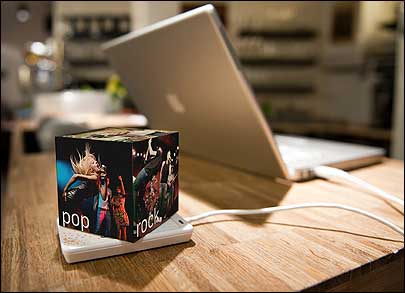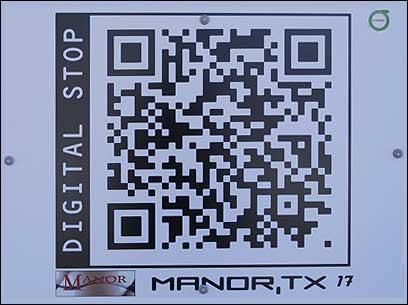When first announced in late 2008, Alcatel-Lucent‘s tikitag RFID tag and reader offering was targeted mostly at consumers, though business applications were in the works as well (see Alcatel-Lucent Launching Consumer RFID Product). Now, roughly six months later, the system has been relaunched with a new name—touchatag—and a new, sharper focus on business applications, ranging from electronic payments and interactive marketing to workforce solutions and information-gathering at events.
Touchatag hardware consists of a small interrogator (roughly the size of a deck of cards, but half the thickness) that connects to a computer through a USB port, and small adhesive passive tags that comply with the 13.56 MHz and ISO 14443 air-interface standards, as well as the Near Field Communications (NFC) protocol, an RFID platform designed for short-range secure wireless transmissions. A touchatag can also be read by placing it very close to an NFC-enabled cell phone. Nokia sells its 6212 handset with NFC in the United States, while Motorola, Samsung and other handset makers offer them in other countries.

The idea behind the offering is that consumers or business users will employ the interrogator to read a unique ID number encoded to each tag, then associate it with online content, such as a URL, or with an online application. Presently, developers have created several applications, which include applying a number of tags to a cube and then associating each tag with a different iTunes control command, such as play, pause or shuffle songs, or with a different genre of music to play.
So by reading the tag, the touchatag interrogator can bridge the physical tag with the virtual world. Although NFC phones can be used for simple commands, such as launching a URL without having to type its address into the phone’s Web browser, the software required to enable phones to run applications is still in development, says Toon Coppens, touchatag’s founder at Alcatel-Lucent.
New to touchatag is an ability to read QR bar codes—2-D bar codes that can be encoded with more data than conventional bar codes, and that can also be decoded by a cell phone equipped with a camera or QR bar-code scanner. To bridge QR codes with touchatags, users can associate the two identifiers when encoding them with the same URL. When utilizing a cell phone to read either the QR code or, if the phone can read NFC tags, the touchatag, the cell phone will launch the same URL.
The software engine that runs touchatag is the Application Correlation Server (ACS), a Web-based service that manages the link between an RFID tag or QR code and a corresponding action to be initiated. When it reads a tag, the touchatag interrogator or NFC phone automatically connects with the ACS, which then directs the phone or computer linked to the reader to access the appropriate online content and applications. (Click here for a demonstration video.)
Dustin Haisler, the chief information officer of the city of Manor, Texas, first read about touchatag (then known as tikitag) about a year ago. Haisler says he quickly thought it could serve as an inexpensive technology for some innovative applications in the small but growing northwest town of Austin, which has roughly 6,500 residents.
Throughout Manor, there are a number of locations, ranging from tourist sites with historical significance to banal municipal sites such as a water tank and a waste processing facility, at which Haisler has installed what he calls digital stop signs. These are large (up to 4-foot-square, so they can be easily seen from a distance) QR codes that are mounted on signs or light-poles.

Attached to each QR code is a touchatag, so visitors can access more information by either scanning the code or reading the tag with an NFC phone. Together, Haisler says, the sites comprise what Manor dubs the Smart Tour, the objectives for erecting which are twofold. One obvious benefit is that it provides visitors with quick access to information about the city, which they can then read on their phones and access again at a later date, rather than just reading information on a sign at a particular spot. And for local residents, the smart tour promotes transparency into city workings.
“If we have a bond project to build a water tower,” Haisler explains, “residents can go to the construction site and access information [through the digital spot sign] about how much the project costs, when it will be completed, etc. It helps us make our government transparent.”
Another application that Manor has launched allows its city council members to easily access and search through materials they need to read prior to council meetings.
“Council members used to get giant binders before each meeting,” Haisler states. “It took lots of preparation work and consumed a lot of paper.” The information is accessible online, but the URL at which the data is stored is long and difficult to key in. What’s more, not all council members are tech-savvy—some do not even maintain bookmarks on their browsers. So the city issued a touchatag reader to each council member, which they could connect to their home PC or Mac, and also offered each a touchatag whose ID number is associated with the URL at which the meeting material is stored. Being able to access the information online also enables council members to seek out specific terms or keywords in the documents, which are now viewed online rather than on paper. They, of course, can choose to print out all or part of the data at home if they so desire.
Another application Haisler envisions is to issue cards to residents and attach a touchatag to each card that would serve to identify its owner’s utility account. Armed with a touchatag reader at home, or with an NFC phone, a resident could utilize the tag to call up his or her account online, in order to review or pay it. Or that individual could bring the card to a utility office, where a touchatag would be linked to a computer for his or her use.
Alcatel-Lucent hopes many more businesses or government agencies will find similar uses for the touchatags and/or QR codes. The firm has conceptualized a number of business applications at its Web site. Proposed uses include employing a reader station at a business conference to interrogate the touchatags embedded in conference badges, in order to exchange contact information with a business associate.
Programmers are encouraged to dream up new applications for touchatag, and can download an interface that will help them get started. Alcatel-Lucent also set up a Web site at which developers can share and promote their projects.
In an e-mail to RFID Journal, Coppens notes that although the touchatag reader could recognize a broad set of NFC RFID tags beyond the touchatag tag, “we have not opened the touchatag reader to read non-touchatag tags, as we want to guarantee the right quality of service to be delivered to users. In our touchatag tag, we have inserted advanced security codes to guarantee the uniqueness of the tag—e.g., in the near future, people will be able to certify non-touchatag tags to work with the touchatag service and applications. There are over two billion [ISO 14443] RFID cards out in the market which can potentially work with the touchatag service [such as fare cards for mass transit systems].”

